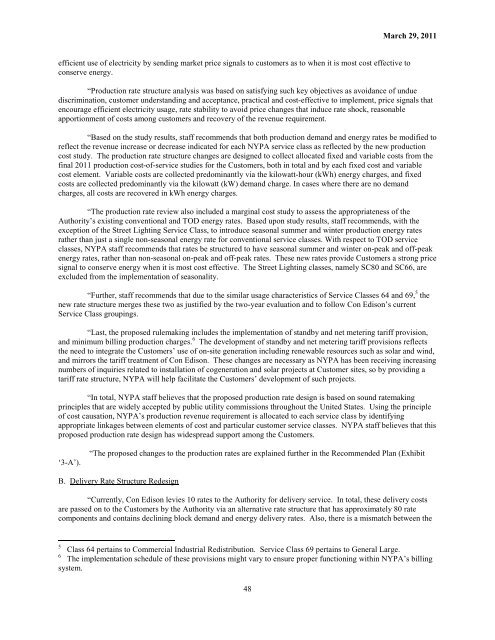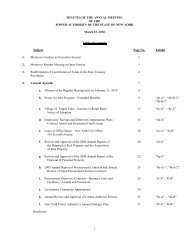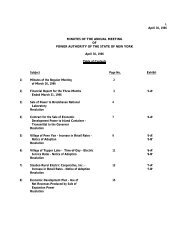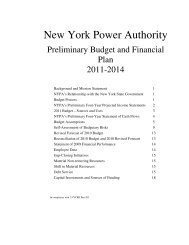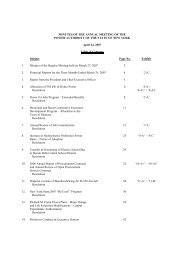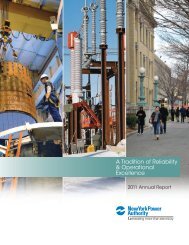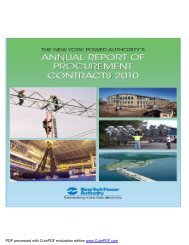March (pdf) - New York Power Authority
March (pdf) - New York Power Authority
March (pdf) - New York Power Authority
You also want an ePaper? Increase the reach of your titles
YUMPU automatically turns print PDFs into web optimized ePapers that Google loves.
<strong>March</strong> 29, 2011<br />
efficient use of electricity by sending market price signals to customers as to when it is most cost effective to<br />
conserve energy.<br />
“Production rate structure analysis was based on satisfying such key objectives as avoidance of undue<br />
discrimination, customer understanding and acceptance, practical and cost-effective to implement, price signals that<br />
encourage efficient electricity usage, rate stability to avoid price changes that induce rate shock, reasonable<br />
apportionment of costs among customers and recovery of the revenue requirement.<br />
“Based on the study results, staff recommends that both production demand and energy rates be modified to<br />
reflect the revenue increase or decrease indicated for each NYPA service class as reflected by the new production<br />
cost study. The production rate structure changes are designed to collect allocated fixed and variable costs from the<br />
final 2011 production cost-of-service studies for the Customers, both in total and by each fixed cost and variable<br />
cost element. Variable costs are collected predominantly via the kilowatt-hour (kWh) energy charges, and fixed<br />
costs are collected predominantly via the kilowatt (kW) demand charge. In cases where there are no demand<br />
charges, all costs are recovered in kWh energy charges.<br />
“The production rate review also included a marginal cost study to assess the appropriateness of the<br />
<strong>Authority</strong>’s existing conventional and TOD energy rates. Based upon study results, staff recommends, with the<br />
exception of the Street Lighting Service Class, to introduce seasonal summer and winter production energy rates<br />
rather than just a single non-seasonal energy rate for conventional service classes. With respect to TOD service<br />
classes, NYPA staff recommends that rates be structured to have seasonal summer and winter on-peak and off-peak<br />
energy rates, rather than non-seasonal on-peak and off-peak rates. These new rates provide Customers a strong price<br />
signal to conserve energy when it is most cost effective. The Street Lighting classes, namely SC80 and SC66, are<br />
excluded from the implementation of seasonality.<br />
“Further, staff recommends that due to the similar usage characteristics of Service Classes 64 and 69, 5 the<br />
new rate structure merges these two as justified by the two-year evaluation and to follow Con Edison’s current<br />
Service Class groupings.<br />
“Last, the proposed rulemaking includes the implementation of standby and net metering tariff provision,<br />
and minimum billing production charges. 6 The development of standby and net metering tariff provisions reflects<br />
the need to integrate the Customers’ use of on-site generation including renewable resources such as solar and wind,<br />
and mirrors the tariff treatment of Con Edison. These changes are necessary as NYPA has been receiving increasing<br />
numbers of inquiries related to installation of cogeneration and solar projects at Customer sites, so by providing a<br />
tariff rate structure, NYPA will help facilitate the Customers’ development of such projects.<br />
“In total, NYPA staff believes that the proposed production rate design is based on sound ratemaking<br />
principles that are widely accepted by public utility commissions throughout the United States. Using the principle<br />
of cost causation, NYPA’s production revenue requirement is allocated to each service class by identifying<br />
appropriate linkages between elements of cost and particular customer service classes. NYPA staff believes that this<br />
proposed production rate design has widespread support among the Customers.<br />
‘3-A’).<br />
“The proposed changes to the production rates are explained further in the Recommended Plan (Exhibit<br />
B. Delivery Rate Structure Redesign<br />
“Currently, Con Edison levies 10 rates to the <strong>Authority</strong> for delivery service. In total, these delivery costs<br />
are passed on to the Customers by the <strong>Authority</strong> via an alternative rate structure that has approximately 80 rate<br />
components and contains declining block demand and energy delivery rates. Also, there is a mismatch between the<br />
5<br />
Class 64 pertains to Commercial Industrial Redistribution. Service Class 69 pertains to General Large.<br />
6<br />
The implementation schedule of these provisions might vary to ensure proper functioning within NYPA’s billing<br />
system.<br />
48


